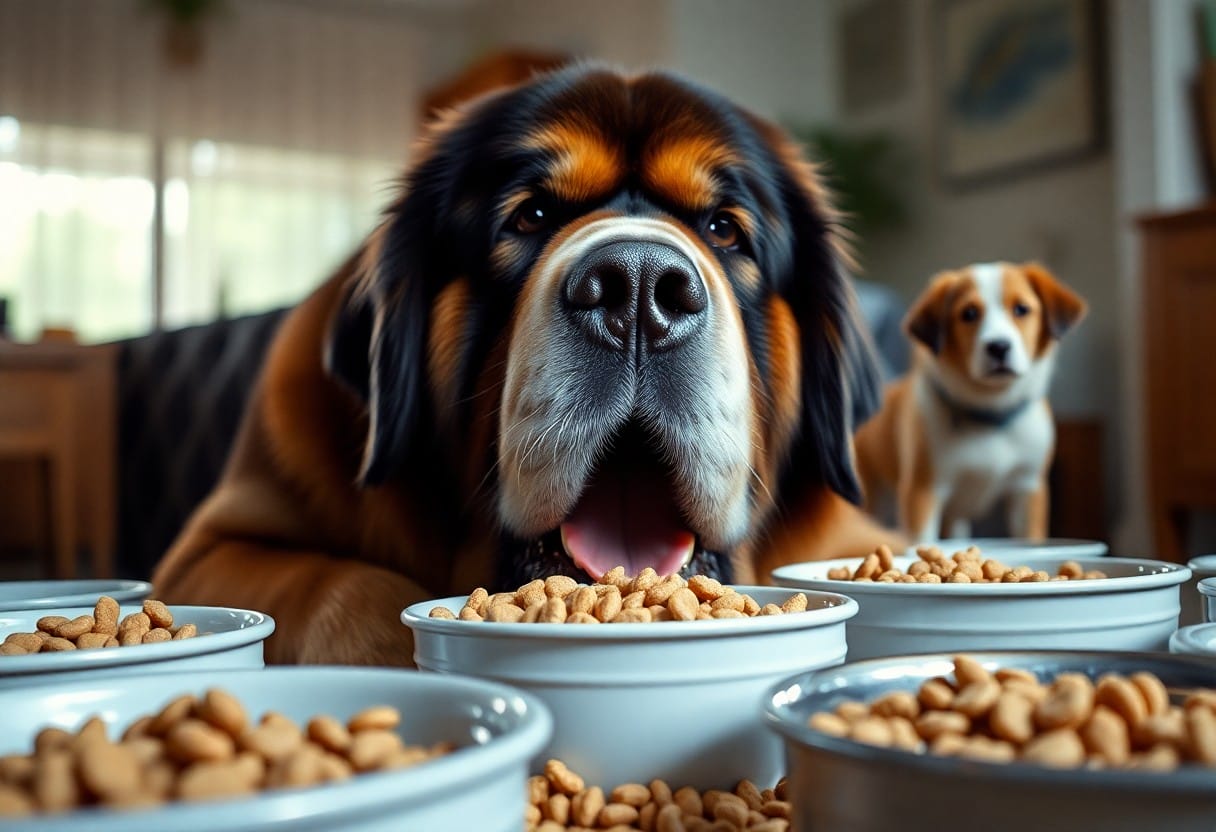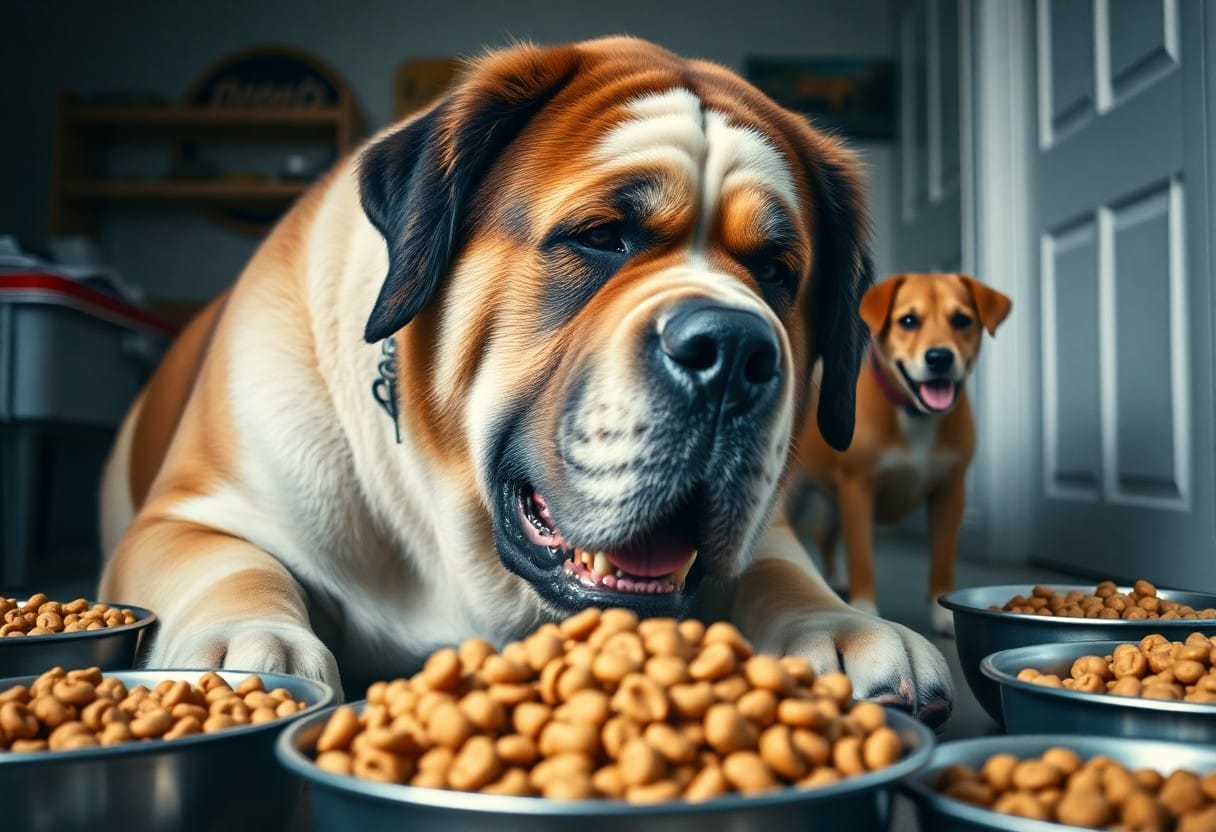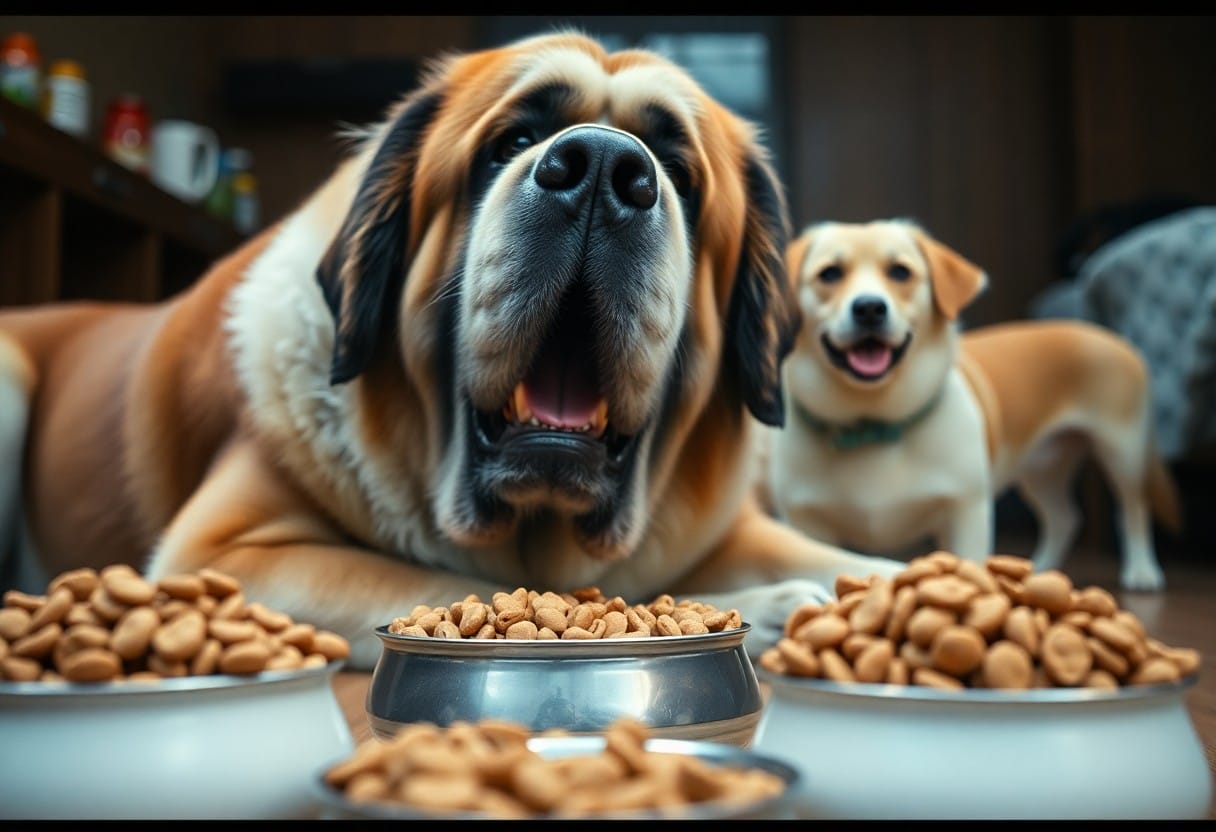
Which dog eat most food?
Share
You might be surprised to learn that the amount of food a dog consumes can vary significantly based on breed, size, and activity level. Some breeds, like the Great Dane and St. Bernard, require a staggering amount of food to support their size, while smaller breeds may eat less frequently but still have hearty appetites. Understanding which dogs eat the most food can help you manage costs and ensure your pet maintains a healthy diet, ultimately leading to a happier, more energetic companion.

Key Takeaways:
- Large Breed Dogs: Generally, larger dog breeds like Great Danes and Mastiffs require more food compared to smaller breeds due to their size and energy needs.
- Active Dogs: Dogs that are highly active, such as working dogs and those involved in agility or hunting, tend to eat more to sustain their energy levels.
- Aging Factors: Older dogs may reduce their food intake, but younger dogs, particularly puppies, need a higher quantity of food to support their growth and development.
Factors Influencing Dog Food Consumption
While various elements dictate how much your dog eats, understanding these factors can help you manage their diet effectively. Key influences include:
- Dog's size
- Dog's weight
- Dog's age
- Dog's activity level
- Health conditions
Recognizing these elements will assist you in adjusting your dog’s food intake to ensure they maintain a healthy weight and lifestyle.
Size and Weight of the Dog
Consumption of food in dogs is directly linked to their size and weight. Larger breeds, such as Great Danes or Mastiffs, require significantly more calories compared to smaller breeds like Chihuahuas. The more considerable the body mass, the higher the caloric needs, which translates into increased food consumption.
Age and Activity Level
About your dog’s age and activity level, both play a significant role. Puppies and young dogs tend to have higher metabolic rates and require more nutrients to support their growth. Conversely, senior dogs often have lower energy needs, which means you might need to adjust their food intake accordingly.
With your dog's activity levels, active dogs or working breeds engage in rigorous exercise that necessitates higher food intake to sustain their energy. On the other hand, sedentary dogs require less food. Evaluating your dog's daily activities allows you to tailor their diet, preventing obesity and promoting overall health. Adjusting their meals based on these factors ensures that your dog remains at a healthy weight and has the energy they need for their lifestyle.
Breeds Known for High Appetite
One of the biggest considerations for potential dog owners is the breed’s appetite. Certain breeds, such as those highlighted in 7 Most Food-Obsessed Dog Breeds, Ranked, are notorious for having voracious appetites that can lead to overeating if not managed properly. Understanding which breeds are prone to this behavior is necessary for maintaining your dog's health and well-being.
Large Breeds
At the forefront of high-appetite breeds, large dogs, such as Great Danes and Saint Bernards, are known to consume significant amounts of food daily. Their massive size and muscle mass require a substantial caloric intake to maintain energy levels, which can lead to feeding challenges if you are not vigilant about portion control.
Working Breeds
About working breeds, like the Siberian Husky or Belgian Malinois, these dogs are not only known for their strength and endurance but also for having a remarkable appetite. Their active lifestyles necessitate a higher caloric intake, making it important for you to provide a balanced diet that meets their energy needs.
With working breeds, you should ensure that their diet supports their high energy levels and physical demands. These dogs can easily become overweight if you overfeed them, leading to serious health issues. A well-structured feeding routine combined with regular exercise will help maintain their ideal weight while keeping them happy and healthy.

Comparison of Daily Food Requirements
Not all dog breeds have the same food requirements. Some breeds demand more sustenance due to their size, age, and activity level. Below is a comparison to help you understand the daily food requirements of various dog breeds:
Daily Food Requirements by Breed
| Breed | Daily Food (cups) |
|---|---|
| Great Dane | 8-10 |
| Labrador Retriever | 2-3 |
| German Shepherd | 3-4 |
| Chihuahua | 0.5-1 |
Chart of Popular Breeds
Around the world, some dog breeds are known for having higher food requirements. Understanding these variations will help you adjust feeding quantities to suit your dog’s needs.
Analysis of Feeding Guidelines
Daily food intake can significantly differ based on your dog's specific breed, age, and activity level. It's important to refer to the feeding guidelines provided by your dog's food manufacturer to ensure a balanced diet.
Understanding the specific feeding guidelines for your dog provides vital insights into how much food they truly need. You're encouraged to take into account their *age, breed, and physical activity*, as this directly influences their *nutritional needs*. Underfeeding can lead to *malnutrition* while overfeeding may cause *obesity*, which brings about serious health risks. Therefore, regularly assessing your dog's weight and adjusting food portions accordingly can lead to a happier, healthier life for your furry friend.

Nutritional Needs of High-Eating Breeds
Once again, understanding the nutritional needs of high-eating breeds is vital for responsible dog ownership. These dogs require diets that are rich in protein, fats, and vital vitamins. Choosing the right food can help you maximize their health and energy levels. For insights on what food does a dog like best?, consider both preferences and nutritional value.
Caloric Requirements
Along with specific dietary components, high-eating breeds often have elevated caloric requirements due to their size and activity levels. Regularly assessing your dog's weight and adjusting their food intake accordingly can help maintain a healthy balance. You want to provide sufficient calories while avoiding overfeeding, which could lead to obesity.
Importance of Balanced Diet
One of the key aspects of caring for high-eating breeds is ensuring they receive a balanced diet. This ensures that your dog is not only satisfied but also nourished. A diet lacking in vital nutrients can lead to health disorders and deficiencies. Grain-free options or those rich in omega fatty acids may be beneficial, but you should consult with a vet for the best choices.
Diet choices for high-eating breeds must take into account their need for variety and balance. You should include a mix of proteins, carbohydrates, and fats to offer a well-rounded meal plan. It's also important to avoid fillers that can lead to weight gain without providing vital nutrients. Regular vet check-ups can help ensure your dog is thriving on their diet, allowing you to adjust as necessary to meet their unique health needs.
Implications of Overfeeding
Unlike a well-balanced diet, overfeeding your dog can lead to a series of negative consequences, both physically and mentally. When you provide excessive food, your beloved pet may struggle with obesity, which can reduce their quality of life and shorten their lifespan. Moreover, overfeeding can increase the risk of serious health conditions and behavioral issues, making it vital for you to monitor your dog's food intake and ensure proper portion control.
Health Risks
About the health risks, overfeeding can lead to severe complications such as obesity, diabetes, and joint problems in your dog. These conditions not only create discomfort but also put your dog at a greater risk for life-threatening diseases. By ensuring a measured diet, you can significantly lower these risks and enhance your dog's overall health and longevity.
Behavioral Issues
With improper feeding habits, you may observe behavioral issues in your dog, including increased anxiety or hyperactivity. Overfed dogs often experience swings in energy levels, which can lead to destructive behaviors or frustration when food is not immediately available. This can be particularly challenging for pet owners, as these behaviors can disrupt daily life and your dog's well-being.
Also, overfeeding can affect your dog's mental health, leading to aggressive behavior or separation anxiety. When dogs are constantly rewarded with food, they may develop an unhealthy association between food and comfort, resulting in an inability to cope when food is scarce. By feeding your dog in moderation and reinforcing positive behavior through training, you can cultivate a more balanced, harmonious relationship with your furry friend.
Tips for Managing Feeding Practices
Now, to ensure your dog maintains a healthy weight and diet, consider these effective feeding strategies:
- Establish a consistent feeding routine.
- Measure your dog’s food portions carefully.
- Monitor their weight regularly.
- Avoid giving table scraps.
- Consult your veterinarian for personalized advice.
Perceiving these tips can help you support your dog’s health and well-being.
Portion Control
Any dog owner should be vigilant about the amount of food they provide to their furry friend. This involves measuring out your dog's meals and adhering to feeding guidelines based on their age, size, and breed. Overfeeding can result in obesity and various health complications, so ensuring your dog gets the right portion is necessary for a long, healthy life.
Regular Feeding Schedule
One effective way to maintain your dog's health is by establishing a regular feeding schedule. This means feeding your dog at the same times each day, making it easier for you to monitor their food intake and prevent overeating. Dogs thrive on routine, and a scheduled feeding time can also limit their chances of begging for extra food between meals.
But as you implement a regular feeding schedule, ensure you adjust it based on your dog's activity level and health needs. Regular feeding not only fosters a sense of security in your pet but also helps you track their eating habits. If you notice any sudden changes in appetite or weight, be proactive and consult your veterinarian. This vigilance can help prevent serious issues that may arise from irregular feeding patterns, ensuring your dog remains happy and healthy.
Summing up
Taking this into account, you should consider the breeds known for their large appetites, such as the St. Bernard and Great Dane, as they typically consume more food compared to smaller breeds. It's important to understand your dog's specific needs based on size, activity level, and metabolism to ensure they receive the appropriate amount of nutrition. By doing so, you can maintain your dog's health and well-being while managing their food consumption effectively.
Q: Which dog breed eats the most food on average?
A: The Great Dane is one of the dog breeds that consumes the most food on average. Due to its large size and weight, a Great Dane can require up to 10-15 cups of high-quality dog food daily, depending on its age, activity level, and overall health.
Q: How does a dog's age affect its food consumption?
A: A dog's age plays a significant role in its food consumption. Puppies have higher energy needs and typically eat more frequently but in smaller amounts. Adult dogs require a balanced diet to maintain their weight and energy levels, whereas senior dogs may eat less as their metabolism slows down and they become less active.
Q: Do more active dog breeds eat more than less active breeds?
A: Yes, more active dog breeds generally eat more than less active breeds. High-energy breeds like Border Collies or Labrador Retrievers tend to require more calories to sustain their energy levels, often leading to a higher food intake compared to breeds that are more sedentary.
Q: Are there specific health factors that can increase a dog's food intake?
A: Absolutely, certain health factors can increase a dog’s food intake. Dogs recovering from illness, pregnant or nursing females, and those with high metabolisms may need additional food. It's important to consult a veterinarian to determine the appropriate food quantity based on individual health needs.
Q: How can I determine the right amount of food my dog should have?
A: To determine the right amount of food for your dog, consider its weight, age, activity level, and breed. Use feeding guidelines provided on dog food packaging as a starting point. It's also beneficial to consult with a veterinarian for personalized recommendations to ensure balanced nutrition and health.
